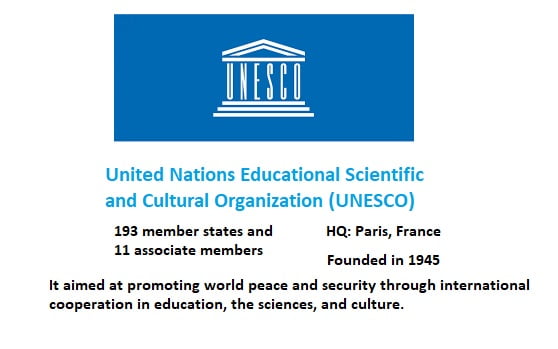United Nations Educational Scientific and Cultural Organization (UNESCO)
Contents
About UNESCO:
- The United Nations Educational, Scientific and Cultural Organization (UNESCO) is a specialised agency of the United Nations (UN)
- It aimed at promoting world peace and security through international cooperation in education, the sciences, and culture.
- It has 193 member states and 11 associate members,as well as partners in the nongovernmental, intergovernmental, and private sector.
- Headquartered at the World Heritage Centre in Paris, France.
- UNESCO was founded in 1945 as the successor to the League of Nations’ International Committee on Intellectual Cooperation.
- UNESCO’s founding mission, which was shaped by the Second World War, is to advance peace, sustainable development and human rights by facilitating collaboration and dialogue among nations.
- It pursues this objective through five major program areas: education, natural sciences, social/human sciences, culture and communication/information.
- UNESCO sponsors projects that improve literacy, provide technical training and education, advance science, protect independent media and press freedom, preserve regional and cultural history, and promote cultural diversity.
- It assists in the translation and dissemination of world literature, helps establish and secure World Heritage Sites of cultural and natural importance, works to bridge the worldwide digital divide, and creates inclusive knowledge societies through information and communication
History of UNESCO
- In 1942, during the Second World War, the governments of the European countries, which were confronting Germany and its allies, met in the United Kingdom for the Conference of Allied Ministers of Education (CAME).
- Upon the proposal of CAME, a United Nations Conference for the establishment of an educational and cultural organization was convened in London in November 1945.
- At the end of the conference, UNESCO was founded on 16 November 1945.
- The first session of the General Conference of UNESCO was held in Paris during November-December of 1946.
What is a World Heritage Site?
- A World Heritage Site is a place on earth having a special cultural or physical significance and outstanding universal value to the humanity.
- It may be a building, a city, a complex, a desert, a forest, an island, a lake, a monument, or a mountain.
- They have been inscribed on the World Heritage List to be protected for future generations to appreciate and enjoy.
How is a World Heritage Site selected?
- The first step towards the listing is the nomination of a site by the respective government of a country.
- The site should have an Outstanding Universal Value (OUV) for World Heritage nomination.
- To determine the Outstanding Universal Value (OUV) for World Heritage nomination, there are ten enlisted criteria.
- The proposed nomination must satisfy at least one of these ten criteria.
- The Nomination File is then evaluated by the International Council on Monuments and Sites and the World Conservation Union.
- These bodies then make their recommendations to the World Heritage Committee.
- The Committee meets once per year to determine whether or not to inscribe each nominated property on the World Heritage List and sometimes defers the decision to request more information from the country which nominated the site.
What are the ten criteria for determining Outstanding Universal Value (OUV)?
- to represent a masterpiece of human creative genius;
- to exhibit an important interchange of human values, over a span of time or within a cultural area of the world, on developments in architecture or technology, monumental arts, town-planning or landscape design;
- to bear a unique or at least exceptional testimony to a cultural tradition or to a civilization which is living or which has disappeared;
- to be an outstanding example of a type of building, architectural or technological ensemble or landscape which illustrates (a) significant stage(s) in human history;
- to be an outstanding example of a traditional human settlement, land-use, or sea-use which is representative of a culture (or cultures), or human interaction with the environment especially when it has become vulnerable under the impact of irreversible change;
- to be directly or tangibly associated with events or living traditions, with ideas, or with beliefs, with artistic and literary works of outstanding universal significance. (The Committee considers that this criterion should preferably be used in conjunction with other criteria.
- to contain superlative natural phenomena or areas of exceptional natural beauty and aesthetic importance;
- to be outstanding examples representing major stages of earth’s history, including the record of life, significant on-going geological processes in the development of landforms, or significant geomorphic or physiographic features;
- to be outstanding examples representing significant on-going ecological and biological processes in the evolution and development of terrestrial, freshwater, coastal and marine ecosystems and communities of plants and animals;
- to contain the most important and significant natural habitats for in-situ conservation of biological diversity, including those containing threatened species of outstanding universal value from the point of view of science or conservation.
Some of the Important Initiatives of UNESCO
- World Heritage Convention and List
- World Heritage Convention -1972 links together the concepts of nature conservation and the preservation of cultural properties.
- The Convention defines the kind of natural or cultural sites (World Heritage Sites) which can be considered for inscription on the World Heritage List.
- The States Parties of convention are encouraged to integrate the protection of the cultural and natural heritage into regional planning programmes, set up staff and services at their sites, undertake scientific and technical conservation research.
- It explains how the World Heritage Fund is to be used and managed.
- Globally there are 1121 World Heritage sites in the 167 countries. Meanwhile, India has 38 World Heritage Sites that include 30 Cultural properties, 7 Natural properties and 1 mixed site
- Man and the Biosphere (MAB) Programme
- It is an intergovernmental scientific programme that aims to establish a scientific basis for enhancing the relationship between people and their environments.
- It promotes innovative approaches to economic development that are socially and culturally appropriate and environmentally sustainable.
- The World Network of Biosphere Reserves currently counts 701 sites in 124 countries all over the world, including 21 transboundary sites.
- India has 18 Biosphere reserves out of which 11 have been recognized internationally under Man and Biosphere (MAB) program:
- International Geoscience and Global Geoparks Programme (IGGP)
- International Geoscience Programme (IGCP) harnesses the intellectual capacity of a worldwide network of geoscientists to lay the foundation for our planet’s future, focusing on responsible resource extraction, natural hazard resilience and preparedness, and adaptability in the era of a changing climate.
- UNESCO Global Geoparks (UGGp) are laboratories for sustainable development which promote the recognition and management of Earth heritage, and the sustainability of local communities.
- As of April 2019, there are 147 UNESCO Global Geoparks within 41 Member States, covering a total area of 288,000 km²
- International Hydrological Programme (IHP)
- The Intergovernmental Hydrological Programme (IHP) is the only intergovernmental programme of the United Nations system devoted to water research and management, and related education and capacity development
- World Water Assessment Programme (WWAP)
- The growing global water crisis threatens the security, stability and environmental sustainability of developing nations.
- The programme focuses on assessing the developing situation of freshwater throughout the world. It also coordinates the work of 31 UN-Water members and partners in the World Water Development Report (WWDR).
- International Basic Sciences Programme (IBSP)
- It is an international multidisciplinary programme established by UNESCO Member States in order to reinforce intergovernmental cooperation in science to strengthen national capacities in the basic sciences and science education.
Important Reports of UNESCO
- UNESCO Science Report
- UNESCO Science Report maps Science, Technology and Innovation (STI) governance around the world on a regular basis. The report is published every five years, on 10 November, to mark World Science Day for Peace and Development.
- Global Education Monitoring Report
- Global Education Monitoring (GEM) Report carries out its assessment of progress towards the Sustainable Development Goal on education (SDG4) and its 10 targets, as well as other related education targets in the SDG agenda.
- The report examines different accountability mechanisms that are used to hold governments, schools, teachers, parents, the international community, and the private sector accountable for inclusive, equitable and quality education.
- McBride Report of 1980
- The comprehensive report of the MacBride Commission is also named “Many Voices, OneWorld”.
- It analyzed communication problems in modern societies, particularly relating to mass media and news, consider the emergence of new technologies, and to suggest a kind of communication order (New World Information and Communication Order) to diminish these problems to further peace and human development
- UNESCO State of the Education Report for India: Children With Disabilities
- The 2019 report is the first edition of the annual report to be published by UNESCO in India.
- It highlights accomplishments and challenges with regards to the right to education of children with disabilities (CWDs).
- UNESCO’s State of the Education Report 2019 is expected to help the education system better respond to the learning needs of CWDs. This will enable significant progress towards our collective objective of leaving no one behind and provide to all children and youth equitable opportunities for quality learning.
International Days observed at UNESCO
Through UNESCO, the United Nations designates specific days as occasions to mark particular events or topics in order to promote, through awareness and action, the objectives of the Organization.
Some of the International days observed by UNESCO is given in the table below:
| Date | Name |
| 27 January | International Day of Commemoration in Memory of the Victims of the Holocaust |
| 13 February | World Radio Day |
| 8 March | International Women’s Day |
| 22 March | World Water Day |
| 23 April | World Book and Copyright Day |
| 3 May | World Press Freedom Day |
| 25 May | Africa Day/ Africa Week |
| 5 June | World Environment Day |
| 12 August | International Youth Day |
| 15 September | International Day of Democracy |
| 5 October | World Teachers Day |
| 16 November | International Day for Tolerance |
| 1 December | World AIDS Day |
UNESCO and India
India is a founding member of UNESCO.
- The National Commission in India that works with UNESCO (as mandated by UNESCO’s Constitution) is called the Indian National Commission for Cooperation with UNESCO (INCCU).
- The INCCU comes under the Department of Secondary and Higher Education, Ministry of Human Resource Development, GOI.
- Members are elected for four-year terms.
- Located in New Delhi, It is the first and only category 1 Research Institute in the Asia Pacific and focuses on achieving the SDG 4.7 towards education to foster peaceful and sustainable societies.
Source: UNESCO
Also Read
Important International Institutions
Other news and institutions related to United Nations
Discover more from Simplified UPSC
Subscribe to get the latest posts sent to your email.



